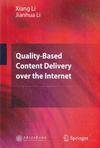基于质量的互联网内容传输技术
2011-3
上海交通大学出版社
李翔,李建华 著
139
In this book, we
try to illustrate the Internet content delivery mechanism. And
based on this mechanism we propose an adaptive content delivery
framework which can greatly help Internet Service Providers and
Internet Content Providers to achieve quality-based content
delivery service. This book can be used as an introduction for
Internet content based technology researchers, and can also be used
as a reference book for graduate students.
This book is the refined wisdom from the
Institute of Information Security Engineering, Shanghai Jiao Tong
University. We appreciate all of our colleagues for their great
help in this book. And we would also express our sincere
appreciation towards Shanghai Jiao Tong University Press. Without
their help, we would never have this book published so
smoothly.
1Introduction
1.1Background
1.2Challenges
1.3Research Topics
1.4Focus of This Book
1.5Book Outline
2Related Work
2.1New Challenges to Web Content
Delivery
2.2Overview of Active Network
2.3Basic Technologies in Active
Network
2.3.1Basic Proxy Caching
2.3.2Transcoding for Pervasive
Intemet Access
2.3.3Adaptive Content
Delivery
2.4Adaptive Web Content Delivery Systems
Built
2.4.1 IBM's Transcoding Proxy
2.4.2Berkeley's Pythia and
TranSend
2.4.3Rice's Puppeteer
2.5Special-Purpose Proxies
2.5.1Compression Proxy
2.5.2WAP Gateway
2.5.3Single Point Transform
Server, ASP
2.5.4Blocking and
Filtering
2.6Analysis of Existing Adaptive Content
Delivery Frameworks and Systems
2.7Summary
References
3Chunk-Level Performance Study for Web Page
Latency
3.1Introduction
3.2Basic Latency Dependence Model
3.3Web Page Retrieval Latency
3.4Experimental Study and Analysis
3.4.1Experimental
Environment
3.4.2Web Page Latency
Breakdown
3.4.3Object Retrieval
Parallelism
3.4.4Definition Time and its
Rescheduling
3.5Discussion about Validity of Observed
Results Under Different Environments
3.6Conclusion
References
4Accelerating Web Page Retrieval Through Reduction in
Data Chunk Dependence
4.1Introduction
4.2Pre-requistes for Rescheduling of
Embedded Object Retrieval
4.3Intra-Page Rescheduling for Web Page
Retrieval
4.3.1Object Declaration
Mechanism (OD)
4.3.2History-Based Page
Structure Table Mechanism (PST)
4.3.3Analysis of Object
Declaration and History-Based PST Mechanisms
4.4Experimental Study
4.4.1Potentials of Push-Forward
and Parallelism Effect in Web Page Retrieval
4.4.2Effect of Object
Declaration Mechanism
4.4.3Effect of History-Based
Page Structure Table (PST) Mechanism
4.4.4Effect of Integrated OD
and PST Mechanism
4.5Conclusion
References
5Modes of Real-Time Content Transformation for Web
Intermediaries in Active Network
5.1Introduction
5.2Basic Web Content Transformation
Model
5.3Modes of Content Transformation on
Streaming Web Data
5.3.1Byte-Streaming
Transformation Mode
5.3.2Whole-File Buffering
Transformation Mode
5.3.3Chunk-Streaming
Transformation Mode
5.4Discussion of the Impact of
Transformation Mode on Web Page Latency
5.5Experimental Study
5.5.1Regrouping and
Push-Backward Effects on Object Perceived Time
5.5.2Regrouping and
Push-Backward Effects on Page Retrieval Time
5.5.3Regrouping and
Push-Backward Effects in the Presence of Proxy Cache
5.6Conclusion
References
6System Framework for Web Content Adaptation and
Intermediary Services: Design and Implementation
6.1Introduction
6.2Basic Proxy Cache
6.2.1DataFlow Path of Proxy
Cache
6.2.2DataFlow Path in SQUID
Proxy Cache
6.3Four-Stage AXform Framework
6.3.1Stage 1 of AXform
Framework: Client Request Stage
6.3.2Stage 2 of AXform
Framework: Server Request Stage
6.3.3Stage 3 of AXform
Framework: Server Data Stage
6.3.4Stage 4 of AXform
Framework: Client Data Stage
6.3.5Summary
6.4System Implementation Considerations for
AXform Framework
6.4.1Handling of Working
Space
6.4.2Accessing Other System
Resources
6.4.3Client Information
Collection
6.4.4Server Information
Collection
6.4.5Environment Parameters
Collection
6.4.6Client Request
Modification
6.4.7HTTP Reply Header
Modification
6.4.8HTTP Body
Modification
6.4.9Cache Related Module
6.5Conclusion
Reference
7Conclusion
7.1Conclusion of the Book
7.1.1Performance Model
7.1.2Improving the Delivery by
Reducing the Object Dependence
7.1.3Transformation Model
7.1.4System Framework and
Requirements
7.2Future Research
7.2.1APIs Definition
7.2.2Unified Data Format
7.2.3Data Integrity and
Security
7.2.4Protocol Design
Index
版权页:插图:In developing the transformation proxy, it is better to make the transformer modular.Hence, one should avoid modifying the working mechanism of the original proxy cacheas much as possible. However, to further utilize the cache system provided by the proxy,we might need to make some modification to the cache related module. There are twokinds of such cache related modules, one for the cache control module and the other forthe cache hit/miss check module. Each of these modules will be discussed below.6.4.9.1 Cache Control ModuleThe cache control module is used by the proxy cache to determine whether the HTTPreply is cacheable. It is triggered between Stage 3 and Stage 4. As we discussed inthe modification of HTTP header, the transformation proxy might sometimes need tooverwrite the rules set by the original server for better caching. This can be done bymodifying the HTTP reply header. But this solution might have undesirable side effects.With the cache control header modified, all the clients and the downstream proxies willget the revised cache control information. There is no way for them to differentiatewhether this rule is set by the original server or by the transformation system. Thismight affect the caches of the clients and downstream proxies. An alternate solution isto modify the cache control module. By applying new rules to the cache control module,we can control the cache management of this working system and at the same timelimit the effect to this system only. For this solution, we need to know the side effect ofdeploying new rules and make sure it will not malfunction.
《基于质量的互联网内容传输技术(英文版)》由上海交通大学出版社出版。
